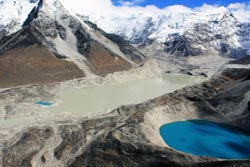State of Himalayan glaciers less alarming than feared

Aerial view of the Imja glacier and Lake Imja, Nepal, the Himalayas. The lake appeared in the 1960s and has grown continuously ever since. The sinking of the surface of the debris-covered glacier tongue is also clearly discernible. Picture: J. Kargel, University of Arizona.<br>
Consequently, it is important to detect the potential impact of climate changes on the Himalayan glaciers at an early stage. Together with international researchers, glaciologists from the University of Zurich now reveal that the glaciers in the Himalayas are declining less rapidly than was previously thought. However, the scientists see major hazard potential from outbursts of glacial lakes.
Ever since the false prognoses of the Intergovernmental Panel on Climate Change (IPCC), the Himalayan glaciers have been a focus of public and scientific debate. The gaps in our knowledge of glaciers in the Himalayan region have hindered accurate statements and prognoses. An international team of researchers headed by glaciologists from the University of Zurich and with the involvement of scientists from Geneva now outlines the current state of knowledge of glaciers in the Himalayas in a study published in Science. The scientists confirm that the shrinkage scenarios for Himalayan glaciers published in the last IPCC report were exaggerated.
Glacier area 20 percent smaller than assumed
The most up-to-date mappings so far based on satellite data revealed that glaciers in the Himalayas and Karakoram cover a total area of approximately 40,800 km². While this is around twenty times larger than all glaciers of the European Alps put together, it is as much as twenty percent smaller than was previously assumed. Lead scientist Tobias Bolch, who researches at the University of Zurich and Dresden University of Technology, mainly puts this down to erroneous mappings in earlier studies.
Less shrinkage than predicted
The scientists took all the existing measurements of length, area and volume changes and mass budgets into account for their study. While some of the measurement series on length changes date back to 1840, measurements of glacier mass budget that instantaneously reflect the climate signal are rare. In addition, continuous measurement series do not stretch back any further than ten years. The researchers recorded average length decreases of 15 to 20 metres and area decreases of 0.1 to 0.6 percent per year in recent decades. Furthermore, the glacier surfaces lowered by around 40 centimetres a year. “The detected length changes and area and volume losses correspond to the global average,” explains Bolch, summarizing the new results. “The majority of the Himalayan glaciers are shrinking, but much less rapidly than predicted earlier.”
For the regions in the northwestern Himalayas and especially in the Karakoram Range, the researchers noted very heterogeneous behaviour in the glaciers. Many of them are dynamically unstable and prone to rapid advances (so called “surges”) that largely occur independently of the climatic conditions. For the last decade on average, even a slight volume increase was detected. Based on their analyses, the researchers assume that glacier shrinkage will not have a major impact on the water drainage of large rivers like the Indus, Ganges and Brahmaputra in the coming decades.
Greater variability and menacing flooding of glacial lakes
Despite the partial all-clear for the Himalayan glaciers, however, Bolch advises caution: “Due to the expected shrinkage of the glaciers, in the medium term we can expect a greater variability in the seasonal water drainage. Individual valleys could dry up seasonally.”
Bolch and his colleagues also see a very serious threat to the local population in newly formed or rapidly growing glacial lakes. The deluge of water and debris from potential outbursts of these lakes could have devastating consequences for low-lying regions. According to the scientists, increased efforts are urgently needed to monitor the lakes as well as changes in the glaciers and the climate in the Himalayas.
The study was conducted as part of the EU project High Noon and the European Space Agency project Glaciers_cci.
Literature:
T. Bolch, A. Kulkarni, A. Kääb, C. Huggel, F. Paul, J.G. Cogley, H. Frey, J.S. Kargel, K. Fujita, M. Scheel, S. Bajracharya, M. Stoffel. The State and Fate of Himalayan Glaciers. Science. April 20, 2012. doi: 10.1126/science.1215828.
Contact:
Dr. Tobias Bolch
Department of Geography
University of Zurich
Tel.: +41 44 635 52 36
Email: tobias.bolch@geo.uzh.ch
Media Contact
More Information:
http://www.uzh.chAll latest news from the category: Earth Sciences
Earth Sciences (also referred to as Geosciences), which deals with basic issues surrounding our planet, plays a vital role in the area of energy and raw materials supply.
Earth Sciences comprises subjects such as geology, geography, geological informatics, paleontology, mineralogy, petrography, crystallography, geophysics, geodesy, glaciology, cartography, photogrammetry, meteorology and seismology, early-warning systems, earthquake research and polar research.
Newest articles

Combatting disruptive ‘noise’ in quantum communication
In a significant milestone for quantum communication technology, an experiment has demonstrated how networks can be leveraged to combat disruptive ‘noise’ in quantum communications. The international effort led by researchers…

Stretchable quantum dot display
Intrinsically stretchable quantum dot-based light-emitting diodes achieved record-breaking performance. A team of South Korean scientists led by Professor KIM Dae-Hyeong of the Center for Nanoparticle Research within the Institute for…

Internet can achieve quantum speed with light saved as sound
Researchers at the University of Copenhagen’s Niels Bohr Institute have developed a new way to create quantum memory: A small drum can store data sent with light in its sonic…




















